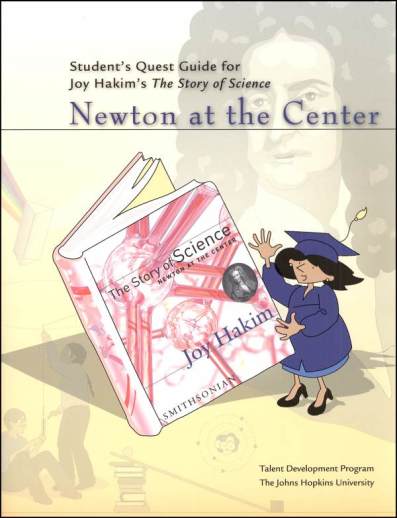With their typical lack of exciting narratives, science and math can be lost to children who may, at the same time, drink up literature and history. After all, science is often presented as a progression of science concepts to learn - and don't forget the list of vocabulary words! If this describes your situation and you're tired of dragging them through the three branches of science, why don't you spend a year studying the history of science? Your guide, Joy Hakim, who has already sparked the interest of countless young readers in history with her History of US series is ready to take you on a tour of scientific discovery from the earliest civilizations to the high-tech science of today. Now, if you're still thinking about History of US, push that thought away and instead imagine a set of hardcover books so gorgeous you could leave them on your coffee table. And beneath those glossy jacket covers you'll find a story so engrossing that you'll want to keep reading! We begin in the first chapter of Aristotle Leads the Way with the Sumerians and other Mesopotamian civilizations. Although the chapter is titled "Birthing a Universe," this is really the story of human scientific discovery, so while various civilizations' creation myths are examined (Genesis is not included in this group) and a basically secular viewpoint is assumed, evolutionary theory is not prominent here. The author writes as if she is having a conversation with the reader, warmly sharing the advances of civilizations and the discoveries of scientific thinkers while she weaves in historical writings and scientific facts. Little-known scientific pioneers are memorably introduced and other historical events of the time are referenced for deeper context. She has a way of making the people you read about seem real, as if they were neighbors from down the street. The other striking things you'll notice are the eye-catching page layout and the loads of full-color photos, period artwork and diagrams. The first book, Aristotle Leads the Way covers Ancient Sumerian civilization to the Age of Exploration in the 1500s. Newton at the Center backs up just a bit, starting in 1453 and stops just short of the 20th century, when scientists are slowly exploring atoms. In Einstein Adds a New Dimension, we learn both about the discoveries made in the last century and the exciting research that is in progress today.
While you could start with these books and build your own curriculum by adding related activities and experiments from topically-organized workbook and experiment resources, there are student and teacher "Quest Guides" available for the first two books in the series. They are easy to follow, can be used in a homeschool or co-op setting, and round out the textbooks by providing thought-provoking questions, hands-on experiments, timeline activities, cross-curricular activity suggestions and more. Most of the "meat" is found in the teacher's guides, so if you are using these as a science course, you will probably want these. The guides are broken down by unit and lesson, usually with one chapter covered per lesson. Units are made up of eight lessons and one assessment lesson, for a total of 45 or 63 lessons in the first two volumes, respectively. Lessons in the teacher's guide typically include an overall theme, goals, reading instructions for the students, directions for including people and events on a timeline, discussion questions for the chapter, guided reading instructions, directions for completing the pages in the student Quest Guide, demonstrations and instructions for related experiments, cross-curricular activity suggestions, journal assignments for students to record what they have learned and more. Units begin with a list of materials needed for each lesson, a unit summary, a list of science experiments used in the unit, a list of assessment activities in the unit, and national standards met by that unit's activities. Fairly lengthy unit assessments are included at the end of each unit, and a whole-book assessment can be found at the end of the teacher's guide. Although written for a classroom situation, the publishers did employ a homeschool consultant to help with homeschool usage, and I think that shows in the flexibility of the guide. While there is a little "fluff" you wouldn't need for a homeschool situation and references to overhead projectors and group activities, most of these things can be easily adapted for use with one or several students. That being said, this would be a terrific program for a co-op situation! The student guides contain the worksheets that are introduced and explained in more detail in the teacher's guides. There is a nice variety of writing activities, scientist information sheets to complete, and experiment worksheets included which tie the reading and the scientific concepts together very nicely. Although you could use the student guide alone, simply for the activities, you would be missing out on the worksheet answers, timeline activities, unit planning helps, discussion questions, activity suggestions and assessments
When all three units are completed, this would make a great year-long curriculum for the home or co-op situation (you could stretch it into two if you want to move at a slower pace, or incorporate hitsory lessons as well). Unfortunately, the curriculum for Einstein... is still in development, but we will add it when it becomes available. You may want to note that although the series is intended for middle school, some rather challenging material is incorporated - it's not a light-weight course! However, if you're looking for a break from "traditional" science," this curriculum provides an excellent overview of science through history, while covering many scientific concepts in a memorable way! – Jess


